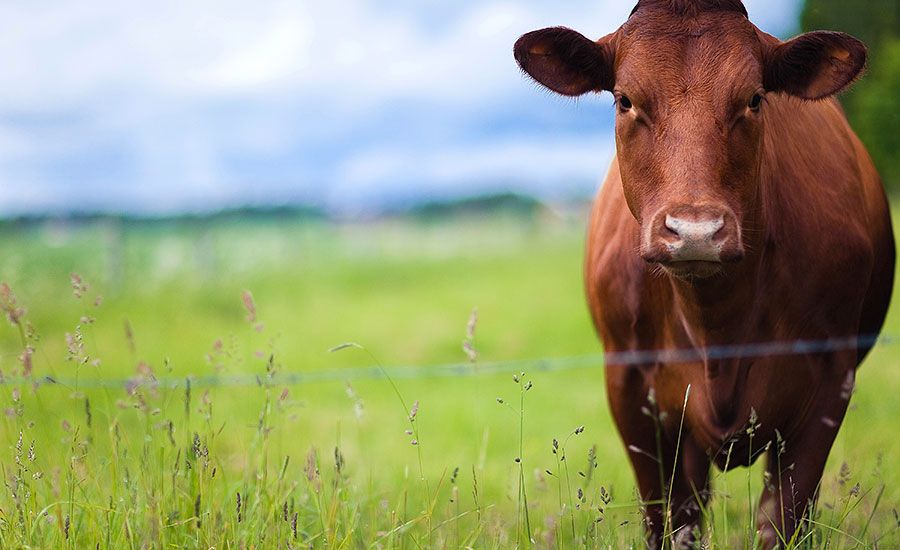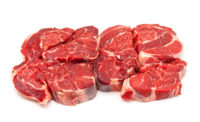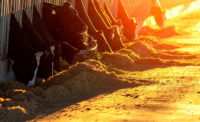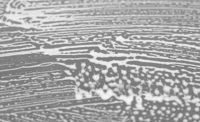Meat Science Review
Direct-fed microbials and S. enterica in bovine subiliac lymph nodes

Current research has implicated bovine lymph nodes as a potential source of Salmonella contamination of ground beef. Until recently, Salmonella cross-contamination of the carcass was believed to occur via the hide or the intestinal tract during slaughter. Many beef processing facilities have implemented effective food safety interventions to control this manner of contamination. Despite controls, Salmonella can be a contaminant of raw ground beef, and data indicates that bovine lymph nodes are protecting Salmonella from post-harvest interventions. Furthermore, it is not practically possible to completely remove all lymph nodes from a beef carcass, creating potential for contaminated lymph nodes to be incorporated into a grind and thus contaminate ground beef product.
With few post-harvest intervention strategies available, investigation of the efficacy of using pre-harvest interventions to control lymph node contamination was necessary. Currently, direct-fed microbials (DFM) are routinely fed as part of feedlot cattle diets, specifically Lactobacillus animalis (NP51) and Propionibacterium freudenreichii (NP24). Data — particularly on the high dose of 109 cfu/head/day — are available on the reduction of E. coli O157:H7 and Salmonella in the feces and on the hides of feedlot cattle being administered NP51 and NP24 in their diets (Brashears et al., 2002, 2003; Elam et al., 2003; Younts-Dahl et al., 2004, 2005; Loneragan and Brashears, 2005; Peterson et al., 2007; Stephens et al., 2007). These studies indicate feeding a DFM could also hold promise for the reduction of Salmonella presence and concentration within bovine lymph nodes.
Recently, researchers from Texas Tech University have shown a reduction of Salmonella within subiliac lymph nodes (SLNs) through the administration of a DFM, in both a small research feedlot study (approximately 4 animals/pen for 117 days), and a large commercial feedlot study (approximately 75 animals/pen). For each study, cattle were randomly allocated into either a treatment or control group. Treatment diets were supplemented with 109 cfu/head/day of the NP51 and NP24 for the entirety of the feeding period, while control diets contained no supplementation. During slaughter, one SLN per carcass was collected for qualitative and quantitative microbial analysis. Quantitative results are presented on cfu/g and cfu/node basis.
In the smaller study (n=99), cattle administered NP51 and NP24 were 82 percent less likely to have Salmonella recovered from SLNs of treatment cattle. Due to the duration of the larger commercial feedlot study (n=627) a total of three separate slaughter days occurred, resulting in different amounts of day on feed (129, 142, and 151 days, respectively). Effects from the same dose in the commercial feedlot study varied across slaughter day, indicating time on feed may have an impact on overall efficacy of the DFM. Salmonella was 50 percent and 31 percent less likely to be recovered from SLNs of treatment cattle on slaughter days one and two. No difference between treatment and control cattle was observed on slaughter day three. Quantitative data was collected for the commercial feedlot study, and a reduction of almost 1-log was observed in Salmonella concentration in SLNs of treatment cattle, on a cfu/g and cfu/node basis.
In both studies, a reduction in the prevalence and concentration of Salmonellawas observed within SLNs. Furthermore, these reductions are consistent with current literature on pathogen reductions in feedlot cattle being administered a DFM. These data do not consider the full complexity of the bovine lymphatic system and therefore only support prevalence on a SLN level, not a carcass level. Moreover, research evaluating the interaction between treatment and time — that was observed in this study — is necessary in order to develop a more complete understanding of the interaction between DFM and Salmonella within SLNs. Nevertheless, these data indicate the administration of NP51 and NP24 — at 109 cfu/head/day — to cattle during the feeding period serves as a potential pre-harvest intervention for reducing the prevalence and concentration of Salmonella within SLNs of beef cattle. NP
References:
- Brashears, M. M., M. L. Galyean, G. H. Loneragan, J. E. Mann, and K. Killinger-Mann, 2002: Prevalence of Escherichia coli O157:H7 and performance by beef feedlot cattle given Lactobacillus direct-fed microbials. J. Food Prot. 66, 748–754.
- Brashears, M. M., D. Jaroni, and J. Trimble, 2003: Isolation, selection, and characterization of lactic acid bacteria for a competitive exclusion product to reduce shedding of Escherichia coli O157:H7 in cattle. J. Food Prot. 66, 355–363.
- Elam, N. A., J. F. Gleghorn, J. D. Rivera, M. L. Galyean, P. J. Defoor, M. M. Brashears, and S. M. Younts-Dahl, 2003: Effects of live cultures of Lactobacillus acidophilus (strains NP45 and NP51) and Propionibacterium freudenreichii on performance, carcass, and intestinal characteristics, and Escherichia coli strain O157 shedding of finishing beef steers. J. Anim. Sci. 81, 2686–2698.
- Loneragan, G. H., and M. M. Brashears, 2005: Pre-harvest interventions to reduce carriage of E.coli O157 by harvest-ready feedlot cattle. Meat Sci. 71, 72–78.
- Peterson, R. E., T. J. Klopfenstein, G. E. Erickson, J. Folmer, S. Hinkley, R. A. Moxley, and D. R. Smith, 2007: Effect of Lactobacillus acidophilus strain NP51 on Escherichia coli O157:H7 fecal shedding and finishing performance in beef feedlot cattle. J. Food Prot. 70, 287–291.
- Stephens, T. P., G. H. Loneragan, E. Karunasena, and M. M. Brashears, 2007: Reduction of Escherichia coli O157 and Salmonella in feces and on hides of feedlot cattle using various doses of a direct-fed microbial. J. Food Prot. 70, 2386–2391.
- Younts-Dahl, S. M., M. L. Galyean, G. H. Loneragan, N. A. Elam, and M. M. Brashears, 2004: Dietary supplementation with Lactobacillus- and Propionibacterium-based direct-fed microbials and prevalence of Escherichia coli O157 in beef feedlot cattle and on hides at harvest. J. Food Prot. 67, 889–893.
- Younts-Dahl, S. M., G. D. Osborn, M. L. Galyean, J. D. Rivera, G. H. Loneragan, and M. M. Brashears, 2005: Reduction of Escherichia coli O157 in finishing beef cattle by various doses of Lactobacillus acidophilus in direct-fed microbials. J. Food Prot. 68, 6–10.
Looking for a reprint of this article?
From high-res PDFs to custom plaques, order your copy today!





